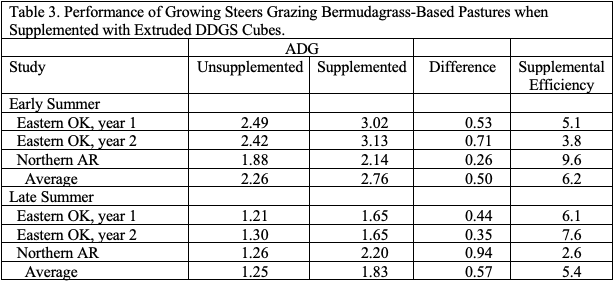Published by Paul Beck, Oklahoma State University State Extension Beef Nutrition Specialist
Forage quality of native range in Oklahoma and the Southern Great Plains declines during the mid to late summer. Research conducted by Dagan Montgomery, a graduate student in the OSU Department of Animal and Food Sciences shows the dramatic decline in the protein and digestibility of native range as the summer progresses.

Performance of stocker calves on native range declines from highs of around 2 pounds per day or more during the spring and early summer to less than one pound per day through the late summer. Deficiency in dietary protein causes dramatic reductions in forage intake and digestibility. A small amount of high protein feed will correct the protein deficiency increasing both forage intake and forage digestibility when adequate forage is available.
In experiments conducted by Oklahoma State University, it was found that feeding 1 pound per day of a high protein supplement (38 to 44% crude protein supplements based on proteins meals such as cottonseed meal or soybean meal) increased average daily gains from 1.13 pounds per day for unsupplemented steers to 1.51 pounds per day. This 0.37 pound per day increase in average daily gain required only 2.7 pounds of feed per pound of added gain.
The Oklahoma Gold Supplementation Program uses these concepts to increase performance and net returns of stocker calves grazing summer grass in the late summer. The Oklahoma Gold Program supplement should be at least 38% crude protein and contain at least 1% phosphorus (to offset mineral deficiencies in our summer grass) and contain an ionophore such as monensin or lasalocid to further increase gains. When an ionophore is included in the supplement, gains were increased by 0.55 pounds per day with a supplemental efficiency of 1.8 pounds of supplement for each pound of added gain. This supplementation program can be fed daily (1 pound of supplement per calf), but it has been found that feeding on alternating days (2 pounds of supplement per calf each feeding) or simply 3 days per week (2.3 pounds of supplement per calf each feeding) is equally effective and may allow calves better access to supplement due to crowding and the low amount of supplement being fed.

The Oklahoma SuperGold Program is similar in concept but was designed to be a better match with grain milling byproduct based supplements. In this program 2.5 pounds of mid-protein (25% crude protein) supplement including an ionophore and required minerals and vitamins is fed per day (or 5.8 pounds fed per feeding 3-days per week), to increase gains by about 0.7 pounds per day. The Oklahoma SuperGold program is expected to add a pound of gain for every 3.5 pounds of supplemental feed.
Recently an extruded distiller’s grains cube has come available in the region. Research by Jordan Adams at Oklahoma State University showed that the extrusion process decreased the fiber content while it increased the crude protein, fat and TDN content of the distiller’s grains.

Research conducted by OSU graduate student, Zane Grigsby, at the USDA Southern Plains Range Research Station near Fort Supply in Northwest Oklahoma on native grass prairie sites investigated using this distiller’s grains cubes in an Oklahoma SuperGold supplementation program for growing steers. In this research, feeding 2 pounds per day (4.7 pound per feeding, 3 days per week) of this extruded distiller’s grains cube during the late summer increased gains by an average of 0.86 pounds per day over 2-years compared with unsupplemented steers, requiring only 2.3 pounds of feed per pound of added gain. In this research mineral supplements containing ionophores were offered free-choice to all calves in a separate complete mineral mix.

In similar research, steers grazing fertilized bermudagrass in Eastern Oklahoma or Northern Arkansas were supplemented with extruded distiller’s grains cubes during the summer grazing season. In Eastern Oklahoma, steers were fed 2.7 pounds per day of the extruded DDG supplement. In the first-year gains during the early summer were increased by 0.53 pounds per day in the early summer and 0.43 pounds per day in the late summer requiring 5.5 to 6.3 pounds of supplement per pound of added gain. In the second year, early summer gains were increased by 0.7 pounds per day with a supplemental efficiency of 3.8 pounds of feed per pound of added gain, but in the late summer gains were only increased by 0.35 pounds per day requiring 7.6 pounds of feed per pound of added gain. In Arkansas, there was no increase in performance when 2.5 pounds of DDGS cubes were fed in the early summer, while in the late summer gains were increased by 0.94 pounds per day, requiring 2.6 pounds of supplement per pound of added gain. The difference in response to supplementation for steers grazing introduced pastures in the east versus native pastures in the west show how timing of rainfall, fertilization, and inherent differences in nutritive quality of different forage species affect response to supplementation. Bermudagrass normally contains adequate protein for growth, but limited energy. These responses are what we expect when providing an energy supplement to grazing steers.

Supplementation of grazing calves during the late summer can be highly profitable even in years with high input costs. There are alternatives available that do not require daily feeding. If supplements containing the mineral and ionophores are not available, feeding the mineral and supplements separately can be equally effective.
A Rancher’s Thursday Lunchtime Webinar Series presentation from July 23, 2020 by Dave Lalman and Paul Beck covers Late-Summer Supplementation to Enhance Cattle Performance.
TALK TO A FEED EXPERT
Get Started
Our team of experienced feed experts and cattlemen are ready to help you change the way you feed. Click the link to schedule a consult!

